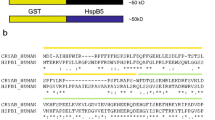Abstract
Protein folding is one of the essential and fundamental processes involved in all living organisms wherein Heat-Shock Protein 90 (HSP90) served as a chaperone which plays important function in protein folding and further promotes refolding of denatured proteins. There are over six hundred identified substrates of HSP90 at present; however, there is a need to develop a specific folding assay method to test its in vitro foldase activity in case of difficulty in substrate activity measurement in vitro. In previous studies, it has been reported that HSP90 is necessary for the stabilization of ZEITLUPE (ZTL) which plays in the circadian clock and photomorphogenesis in Arabidopsis (Kim et al. 2011). Rhythmic oscillations of ZTL protein might be caused by denaturation and stabilization, thus, refolding activity of HSP90 is possibly involved in the oscillations of ZTL protein. However, the question whether HSP90 indeed promotes refolding of ZTL or not has not yet identified and therefore needs to be investigated. Recombinant glutathione-S transferase (GST) fused-ZTL in bacteria was produced and purified as the soluble GST-ZTL through treatments of both sarkosyl and Triton-X100 as ionic and nonionic detergents, respectively. Upon heat (45°C) treatment, the GST activity of GST-ZTL decreased significantly. After the 3 h heat-induced denaturation of GST-ZTL, the refolding of denatured GST-ZTL was enhanced upon addition of HSP90 in a dose-dependent manner. The results from this study showed that recombinant GST-fused protein can be possibly used for in vitro protein refolding assay method. Moreover, results revealed that Arabidopsis HSP90 can efficiently refolds the denatured GST-ZTL in vitro.
Similar content being viewed by others
References
Becker J, Craig EA (1994) Heat-shock proteins as molecular chaperones. Eur J Biochem 219:11–23
Black MM, Stockum C, Dickson JM, Putterill J, Arcus VL (2011) Expression, purification and characterization of GIGANTEA: A circadian clock-controlled regulator of photoperiodic flowering in plants. Protein Expr Purif 76:197–204
Caplan AJ, Jackson S, Smith D (2003) Hsp90 reaches new height. EMBO Rep 4:126–130
Csermely P, Schnaider T, Sti C, Prohászka Z, Nardai G (1998) The 90 kDa molecular chaperone family: structure, function, and clinical applications. Pharmacol Ther 79:129–168
Deuerling E, Bukau B (2004) Chaperone-assisted folding of newly synthesized proteins in the cytosol. Crit Rev Biochem Mol Biol 39:261–277
Dunlap JC (1992) Molecular bases for circadian clocks. Cell 96:271–290
Frangioni JV, Neel BG (1993) Solubilization and purification of enzymatically active glutathione S-transferase (pGEX) fusion proteins. Anal Biochem 210:179–187
Fujiwara S, Wang L, Han L, Suh SS, Salomé PA, McClung CR, Somers DE (2008) Post-translational regulation of the Arabidopsis circadian clock through selective proteolysis and phosphorylation of pseudo-response regulator proteins. J Biol Chem 283:23073–23083
Goloubinoff P, Mogk A, Zvi AP, Tomoyasu T, Bukau B (1999) Sequential mechanism of solubilization and refolding of stable protein aggregates by a bichaperone network. Proc Natl Acad Sci USA 96:13732–13737
Hartl FU (1996) Molecular chaperones in cellular protein folding. Nature 381:571–580
Hutchinson MH, Chase HA (2006) Adsorptive refolding of histidinetagged glutathione S-transferase using metal affinity chromatography. J Chromatogr A 1128:125–132
Jarillo JA, Capel J, Tang RH, Yang HQ, Alonso JM, Ecker JR, Cashmore AR (2001) An Arabidopsis circadian clock component interacts with both CRY1 and phyB. Nature 410:487–490
Kiba T, Henriques R, Sakakibara H, Chua NH (2007) Targeted degradation of PSEUDO-RESPONSE REGULATOR5 by an SCFZTL complex regulates clock function and photomorphogenesis in Arabidopsis thaliana. Plant Cell 19:2516–2530
Kim T, Kim WY, Fujiwara S, Kim J, Cha JY, Park JH, Lee SY, Somers DE (2011) HSP90 functions in the circadian clock through stabilization of the client F-box protein ZEITLUPE. Proc Natl Acad Sci USA 108:16843–16848
Kim WY, Fujiwara S, Suh SS, Kim J, Kim Y, Han L, David K, Putterill J, Nam HG, Somers DE (2007) ZEITLUPE is a circadian photoreceptor stabilized by GIGANTEA in blue light. Nature 449:356–360
Kim WY, Geng R, Somers DE (2003) Circadian phase-specific degradation of the F-box protein ZTL is mediated by the proteasome. Proc Natl Acad Sci USA 100:4933–4938
Lee JR, Lee SS, Jang HH, Lee YM, Park JH, Park SC, Moon JC, Park SK, Kim SY, Lee SY, Chae HB, Jung YJ, Kim WY, Shin MR, Cheong GW, Kim MG, Kang KR, Lee KO, Yun DJ, Lee SY (2009) Heat-shock dependent oligomeric status alters the function of a plant-specific thioredoxin-like protein, AtTDX. Proc Natl Acad Sci USA 106:5978–5983
Lu Z, Cyr DM (1998) Protein folding activity of Hsp70 is modified differentially by the Hsp40 co-chaperones Sis1 and Ydj1. J Biol Chem 273:27824–27830
Más P, Kim WY, Somers DE, Kay SA (2003) Targeted degradation of TOC1 by ZTL modulates circadian function in Arabidopsis thaliana. Nature 426:567–570
Matsushika A, Makino S, Kojima M, Mizuno T (2000) Circadian waves of expression of the APRR1/TOC1 family of pseudoresponse regulaters in Arabidopsis thaliana: Insight into the Plant Circadian Clock 41:1002–1012
Nollen EAA, Morimoto R (2002) Chaperoning signaling pathways: molecular chaperones as stress-sensing ‘heat shock’ proteins. J Cell Sci 115:2809–2816
Scheibel T, Weikl T, Buchner J (1998) Two chaperone sites in Hsp90 differing in substrate specificity and ATP dependence. Proc Natl Acad Sci USA 95:1495–1499
Somers DE, Schultz TF, Milnamow M, Kay SA (2000) ZEITLUPE encodes a novel clock-associated PAS protein from Arabidopsis. Cell 101:319–329
Wang W, Vinocur B, Shoseyov O, Altmant A (2004) Role of plant heat-shock proteins and molecular chaperones in the abiotic stress response. Trends Plant Sci 9:244–252
Weis F, Moullintraffort L, Heichette C, Chrétien D, Garnier C (2010) The 90-kDa heat shock protein Hsp90 protects tubulin against thermal denaturation. J Biol Chem 285:9525–9534
Yonehara M, Minami Y, Kawata Y, Nagai J, Yahara I (1996) Heatinduced chaperone activity of HSP90. J Biol Chem 271:2641–2645
Author information
Authors and Affiliations
Corresponding authors
Rights and permissions
About this article
Cite this article
Cha, JY., Kim, M.R., Kim, WY. et al. Development of in vitro HSP90 foldase chaperone assay using a GST-fused Real-substrate, ZTL (ZEITLUPE). J. Plant Biol. 58, 236–241 (2015). https://doi.org/10.1007/s12374-015-0129-2
Received:
Accepted:
Published:
Issue Date:
DOI: https://doi.org/10.1007/s12374-015-0129-2




